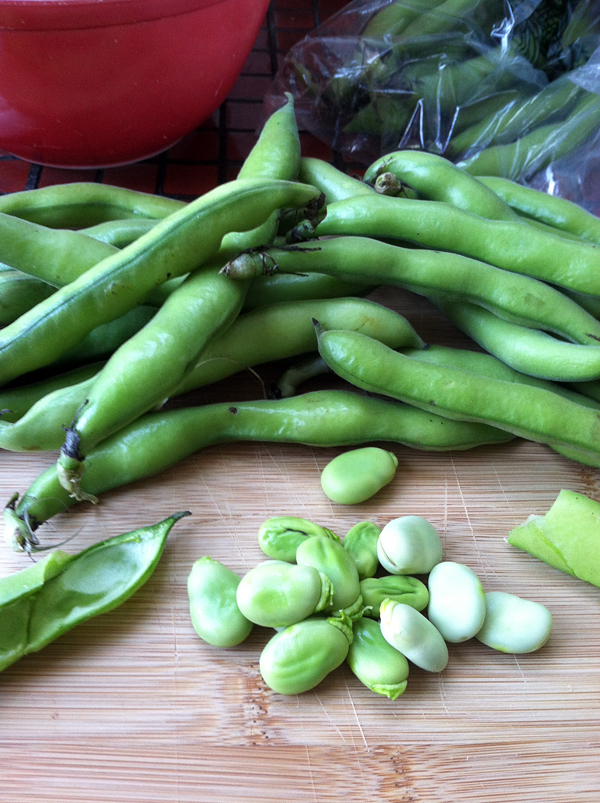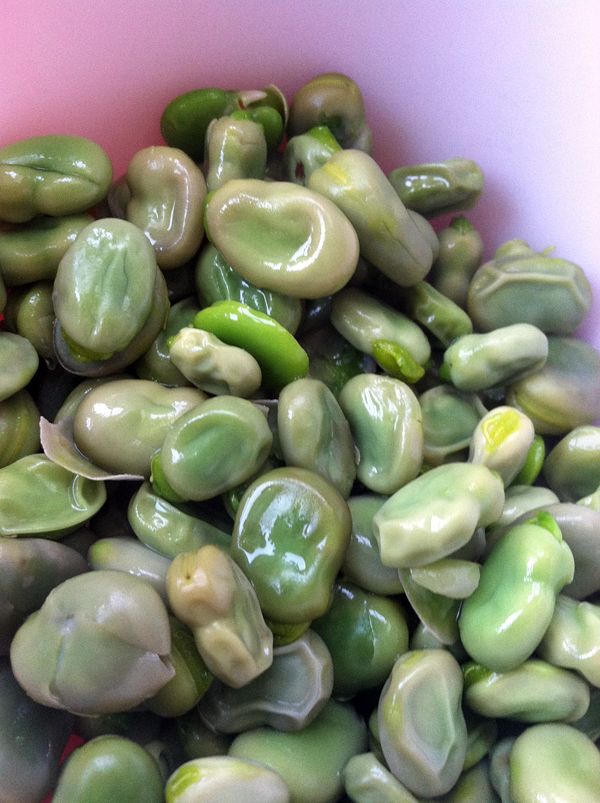
Dump your de-podded favas into your alkalinized water. Let come back to a boil and simmer for a minute or two. Drain and rinse with cold water until cool enough to handle. If they haven’t already busted their coats, pinch off the now-slippery and grayish-pink outer skin and discard. (You may need to rinse the finished beans again to remove any remaining skin debris.) Drop the pretty bright-green bean halves inside into a little bowl. Yes, a little bowl. That’s all you’ll need, trust me, since your two pounds of favas will only net you about 1 1/3 cups of fully denuded beans. Slide your now double-peeled favas into a small skillet with a little olive oil, a few tablespoons of water and a pinch of sea salt.
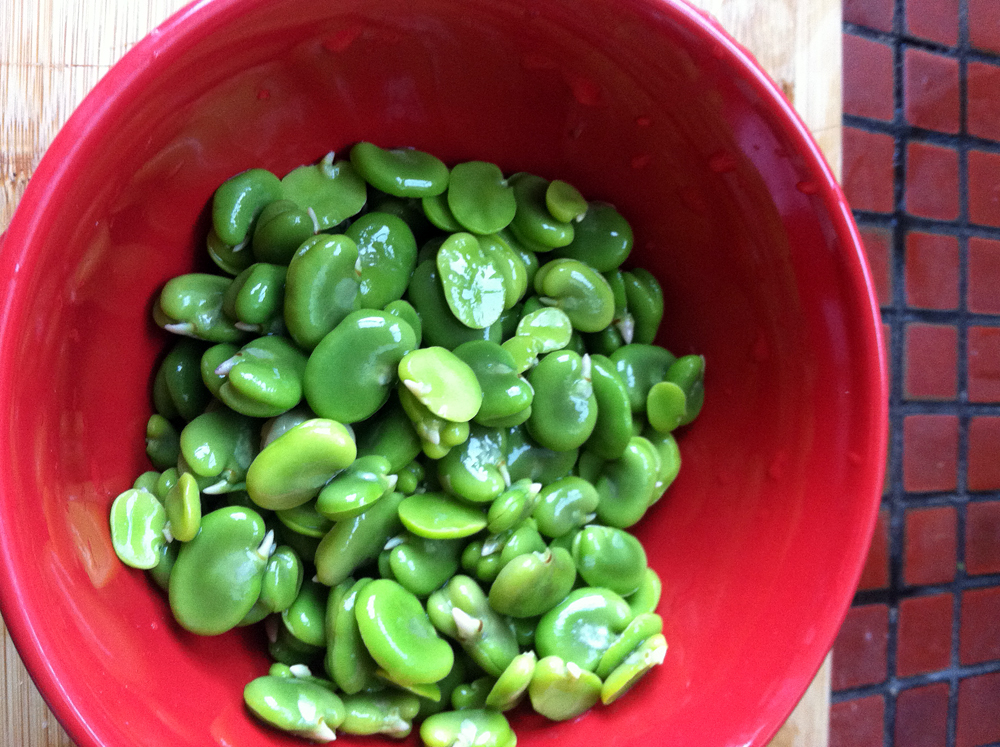
Cook them, stirring, over low heat until tender and nutty tasting, probably around five minutes, maybe less. If you have one of those cute little mini-food-processors, scoop your favas (and whatever liquid might be around them) into the processor, add a squeeze of lemon juice, a little more olive oil and/or water, and pulse to a rough puree. Not too smooth; this isn't hummus.
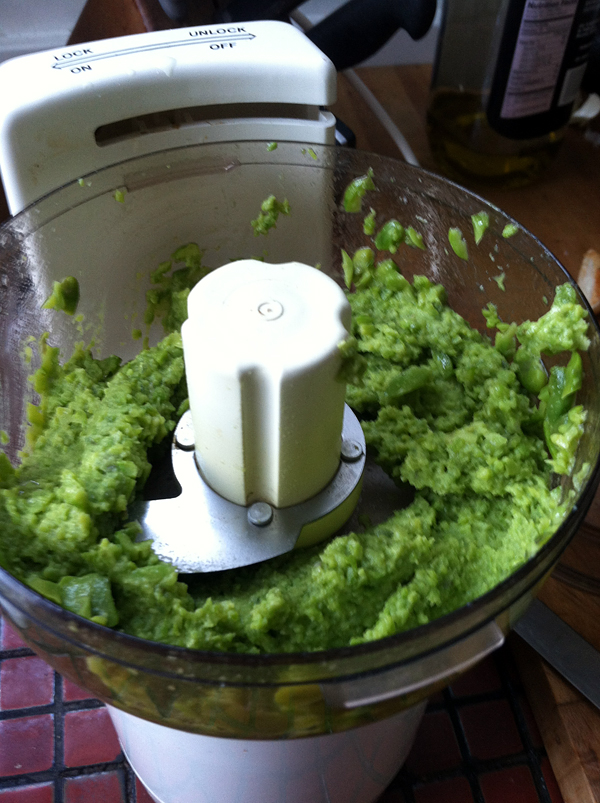
Otherwise, stamp them into a rough paste with one of those waffle-grid-headed potato mashers. (I think if you tried to chop them they’d just go slithering off in every direction all over the counter, and after all that work, you don’t have any to waste.)
Add some freshly ground pepper (preground pepper is as useless, and tasteless, as sand), and taste. Does it taste creamy and nutty and green? Good. Only add more salt and/or lemon if it tastes flat; lemon juice can really jump right out at you and that’s not what you want here. However, if you’re lucky enough to have some Moroccan-style preserved lemons sitting around, you could add a tiny bit of minced preserved-lemon rind to the fava-bean mixture, just to spark it up. Set aside.
Strip some mint leaves from their stems. Lay the leaves one on top of the other in a little leaf stack. Roll up like a cigar and cut into very fine strips. Ah, mint chiffonade. Two words like the tinkle of clear ice in a tall gin and tonic on a summer afternoon–the two words Henry James considered the most lovely in the English language. (No, not mint chiffonade, nor gin and tonic, more’s the pity, but summer afternoon. And this from a man wearing a high collar, waistcoat, suit and tie in the middle of July.)
Then you need a chunk of Pecorino Romano cheese, a firm, salty sheep’s milk cheese similar to Parmesan, and a vegetable peeler. You could use Parmesan instead, but in that case I’d look for a young Parmesan, one that’s still got a little sweetness and elasticity to it, rather than one gone all stark and aged and granular. You could also use a Spanish Manchengo, or my new favorite, an Italian Gran Cacio, a firm sheep's milk cheese found on a quick trip to the Bi-Rite Market cheese display.
Now, cut some very thin slices of baguette. Toast lightly, which is best done on a baking sheet in the oven at around 350°F, for about 5 to 7 minutes. Rub the top side very lightly with a clove of garlic, or even better, with a juicy little chunk of green garlic.
But wait, green garlic? What is that, exactly? So glad you asked! It’s the bulb and stem of the garlic plant in its early stages, before the bulb swells and the cloves separate in the fat, familiar, papery-white bundle we know. At this moment, the bulb is barely a nubbin and the stalk is still flexible and edible. It has the texture of a young leek or extra-firm scallion and a taste that mixes the vegetal greenness of leek with a hint of the earthy warmth of the garlic to come. Basically, these are thinnings, pulled to give more elbow room to the bulbs ripening in the late summer and fall. They seem to be particularly relished (and sold) at farmers’ markets in Northern California, where they have a brief season as harbingers of spring, much like favas, pea shoots, and the first rhubarb and strawberries. Here’s a lovely green-garlic pesto recipe from Stephanie Stiavetti, my KQED colleague and fellow food-writing Stephanie.
Now, back to your baguette slices, waiting for you all garlicked up. Have you noticed how seasonal this little nibble is? How local? Everything, from bread to olive oil to favas, lemons, and mint, can come from some combination of backyard and farmer's market. (For cheese, try Bellwether's Pepato, a peppercorn-studded semi-firm sheep's milk cheese made in Valley Ford.)
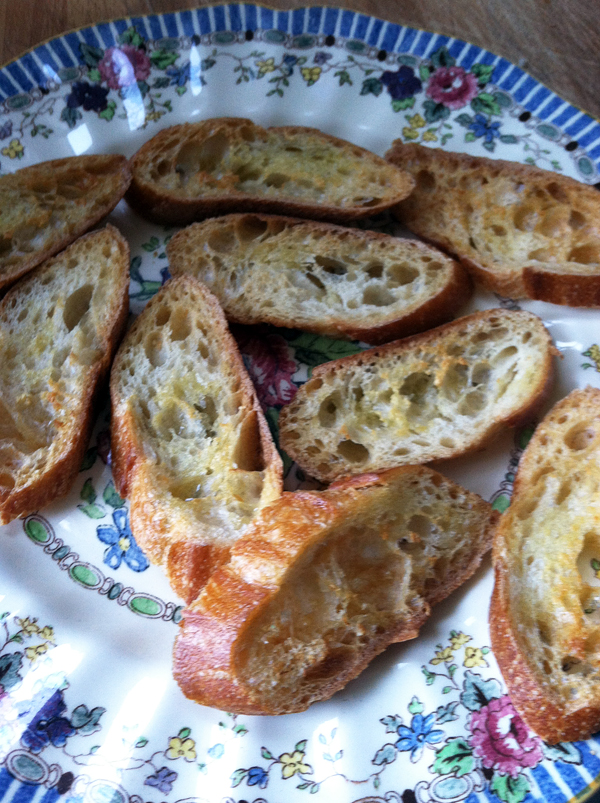
Drizzle or brush some good olive oil on your toasts. Return to the oven to continue crisping up and browning. You don’t want it much more than golden brown around the edges, but you do want it nice and crunchy all the way through. The oven is better for this kind of slow crisping than the toaster, which will give you fast brown edges but a chewy center.
Once your toasts are ready, spread a spoonful of fava mixture onto each toast. Don’t be stingy, baby! Swirl it on nice and thick, like icing on a cupcake. Strew a few mint shreds over the favas. Using your little vegetable peeler, add a couple sheer curls of Pecorino Romano cheese. Nicest served while the toasts are still warm, but that’s a frill.
All this work and you will probably end up with anywhere from 10 to 12 toasts, depending on how many favas you could bear to peel. What this means, of course, is that, as with fried zucchini blossoms, these should only be served to a small group of people you really, really like.

Best of all, really, is sitting in the back garden, lilacs on the table, something sparkling in your glass, toasting your good fortune with your one very favorite, most fava-worthy friend, whether sweetheart or pal. Happy Spring!
Recipe: Fava-Bean Crostini
